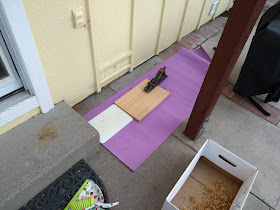 |
| My tools for this build, minus the drill that I borrowed. |
The picture above shows almost everything that I used: a carpenter's speed square ($.75 at Lowe's), some sand paper (I wound up also getting some 220 grit and some 600 grit), a marking gauge, an aftermarket iron and chip breaker (which I wound up not using) for the plane, a 5/8" Kobalt chisel (about $10 at Lowe's), my trusty Dick saw, a tapered drill bit, my leather strop, a hefty ball-peen hammer that I picked up by chance at an estate sale in Nevada for $2, and a Sargent #414, the equivalent of a #5. The plane was about $50 including shipping from a guy on Facebook.
Also pictured are the nails and hinges I used (one example of each).
The only other tools I can think of that were used was my sister's Black and Decker cordless drill, a drill bit from her kit, and a screwdriver handle of hers that must have come from IKEA.
Oh, I almost forgot, I used her yoga mat, too.
 |
| 20 feet of cedar. |
The wood I encountered at Lowe's and Home Depot wasn't the greatest I've ever seen, but they both had selections that were a hundred times better than anything you can find at a home center in Europe. There were even two different grades of 1x12s that would have worked, in a pinch. The problem was the construction grade stuff I found wasn't so great, and the nice stuff was very expensive.
I wanted to go to a proper lumberyard, but I was able to find what I needed at a Meeks hardware and lumber store. I'm told this company is local to the area, and they seemed to market more to the professional contractor rather than the DIYer. At Meeks I was able to find a white cedar 1x12 that was 20 feet long, nearly free of defects, and surfaced on one side.
It sounded perfect, but I had never worked with cedar before, so I crossed my fingers and bought it. I was able to crosscut it to lengths that would fit in my sister's Toyota Camry (two 4 foot lengths and two 6 foot lenths) on the panel saw they had.
My biggest challenge by far was the deadline. The chest had to be completed with finish before I left. Theoretically, it should have been easy, as I had no fixed plans during the ten days I was there. I do have two sisters that live there, and my parents and another sister came down from Montana for a little celebrating since I don't get back to the states often.
Soon after I bought the lumber, my dad had a medical emergency and spent three days in the hospital. This completely changed the nature of my visit. I can't tell you how much I wanted to abandon this project. I'm sure if I had, no one would have blamed me.
Fortunately, my dad was discharged and it looks like he will make a full recovery. Once the stress of this emergency was out of the picture, building furniture was a great diversion. Dad even helped!
 |
| Sharpening the chisel with sandpaper. |
 |
| Sargent 414 |
Indeed, it only took 20 minutes to clean up. I chose not to lap anything, just to use it after removing the grime. I was impressed that about 98% of the original Japanning was there. It was probably protected by all the dirt.
The problem I found with it was after cleaning, I discovered that the lever cap for this was incorrect, and the business end of the lever cap hung out over the top of the hump on the cap iron. It couldn't be used like this, because every shaving I take is likely to get jammed in that exact spot.
The seller was great and tracked down a new lever cap for me and shipped it out as soon as possible, which unfortunately arrived the day after I left.
 |
| You can see the lever cap sticking out over the blade in this pic. |
 |
| A beautifully crafted plane. I've always liked Sargents. |
Jonas from Mulesaw came to the rescue. I explained my problem to him during one of our many chats, and he suggested using a washer on the screw so I could back the lever cap up a bit so the business end was in the correct place. I went back to Meeks, and spent $.23 on a steel washer that worked perfectly. It just meant that every time I wanted to remove the blade, I had to unscrew the whole thing.
 |
| $.23 put this plane back to work thanks to Jonas. |
No problem.
 |
| A yoga mat and a plastic cutting board butted up against a concrete step did the trick. |
I wound up not flattening the boards that I used. I smoothed them with the plane, and left the cup in. My dad helped a bit here, as it was difficult to plane the inside of the concave side because the blade couldn't reach down to the bottom of the cup. My dad stood on various parts of the board to push it flat while I smoothed. It worked perfectly. However, planing on the ground sucks the big one.
There was also a half-wall made of cinder blocks next to my sister's shed that worked great as a joinery bench and a saw bench. It was perfectly suited to use with the Japanese Dick saw.
 |
| Dad helped here by holding things stable while I worked. He turned out to be a pretty good meat clamp. |
If you haven't seen the first post in this series, check it out here.
Inspiring and hilarious at the same time. Glad your Dad is OK.
ReplyDeleteThanks, Jeff!
ReplyDelete